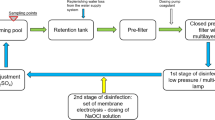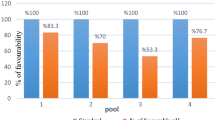Abstract
In this study, the variations in concentrations of some disinfection chemicals such as cyanuric acid (CyA), free chlorine (FC), and residual chlorine (RC), which affect human health, were investigated in the water of swimming pools. In addition, quality parameters such as temperature, pH, and total alkalinity (TA) in 44 swimming pools located in the city center and districts of Canakkale, Turkey, were examined in the summer period. While FC and RC amounts were analyzed using tablet tests with N-N-diethyl phenylenediamine (DPD 1) and potassium iodine (DPD 3) using the colorimetric method in the comparator, TA and CyA levels were measured with a photometric method. Temperature and pH were measured using YSI 556 MPS. Levels of CyA, FC, RC, pH, temperature, and TA varied between 0.00 and 725.0 mg L−1 (108.0 ± 111.4 mg L−1), 0.00 and 5.00 mg L−1 (1.60 ± 0.962 mg L−1), 0 and 0.55 mg L−1 (0.087 ± 0.059), 6.40 and 8.20 mg L−1 (7.30 ± 0.038 mg L−1), 22.0 and 32.0 °C (27.6 ± 1.45 °C), and 0.00 and 391.0 mg L−1 (129.3 ± 89.0), respectively. The findings were compared to standard limit values of the Ministry of Health of the Turkish Republic and other countries. Not only maximum concentrations of CyA but also the average concentrations exceeded the standard limit values of different countries in July and August with high tourism activity in Turkey. Although there is no problem in view of average values of other quality parameters, there are some problems in view of the maximum values in pool waters compared to standard limit values.









Similar content being viewed by others
References
Amburgey, J. E. & Anderson, J. B. (2011). Disposable swim diaper retention of Cryptosporidium-sized particles on human subjects in a recreational water setting. Journal of Water Health, 9(4), 653–658.
Anonymous. (1998). Drinking Water Contaminant List Document (vol 12 pp. 98–102). Washington: Environmental Protection Agency (EPA).
Anonymous. (2011). Regulation on the principles and conditions of health in the swimming pools. Ankara: Turkish Health Ministry (in Turkish).
Bolukbasioglu, S., & Bolukbasioglu, A. S. (2009). Swimming Pool Installation, Operation and Maintenance (pp. 186). Istanbul: Santem Industry-Housing Industry and Trade Inc. (in Turkish).
Canelli, E. (1974). Chemical, bacteriological and toxicological properties of cyanuric acid and chlorinated isocyanurates as applied to swimming pool disinfection. American Journal of Public Health, 64 (2), 155–162.
Clasen, T., & Edmondson, P. (2005). Sodium dichloroisocyanurate (NaDCC) tablets as an alternative to sodium hypochlorite for the routine treatment of drinking water at the household level. International Journal of Hygiene and Environmental Health, 209(2), 173–181.
Dallolio, L., Belletti, M., Agostini, A., Teggi, M., Bertelli, M., Bergamini, C., et al. (2013). Hygienic surveillance in swimming pools: assessment of the water quality in bologna facilities in the period 2010–2012. Microchemical Journal, 110(2), 624–628.
Dedeoğlu, H. T. (2009). Pool operator’s manual (pp. 14–68). İstanbul: National Pool Institute (UHE).
Gulluoglu, S. (2012). Pool, child and disinfection: disinfection of swimming pool water. Ankara: Limited Company of Printing, Publishing Industry Trade Organisation 250 p (in Turkish).
Hammond, B. G., Barbee, S. J., Inoue, T., Ishida, N., Levinskas, G. J., Stevens, M. W., et al. (1986). A review of toxicology studies on cyanurate and its chlorinated derivatives. Environmental Health Perspectives, 69, 287–292.
Huthmacher, K., Dieter Most, D. (2005). Cyanuric Acid and Cyanuric Chloride. Weinheim: Ullmann’s Encyclopedia of Industrial Chemistry, Wiley-VCH.
Kababjian, R. S. (1995). Disinfection of public poos and management of fecal accidents. Journal of Envirinmental Health, 58(1), 8–12.
Karns, J. S. (1999). Gene sequence and properties of an s-triazine ring-cleavage enzyme from Pseudomonas sp. strain NRRLB-12227. Applied and Environmental Microbiology, 65(8), 3512–3517.
Kirk, O. (1993). Encyclopedia of Chemical Technology (pp: 1084) (pp. 1–26, p. 834–851). New York: John Wiley & Sons.
Kowalski, X., & Hilton, T. B. (1966). Comparison of chlorinated cyanurates with other chlorine disinfectants. Public Health Reports, 81(3), 282–288.
Kowalsky, L. (1992). Certified pool-SPA operator (pp: 46). Texas: National Swimming Pool Foundation.
Loret, J. F., Robert, S., Thomas, V., Cooper, A. J., McCoy, W. F., Levi, Y. (2005). Comparison of disinfectants for biofilms, protozoa and Leonella control. Journal of Water Health, 34, 423–433.
Magnuson, M. L., Kelty, C. A., & Cantú, R. (2001). Stable association complex electrospray mass spectrometry for the determination of cyanuric acid. Journal of the American Society for Mass Spectrometry, 12(10), 1085–1091.
McDonald, T. A., & Komulainen, H. (2005). Carcinogenicity of the chlorination disinfection by-product MX. Journal of Environmental Science and Health. Part C, Environmental Carcinogenesis & Ecotoxicology Reviews, 23(2), 163–214.
Mukherjee, S., & Ren, J. (2010). Gas-phase acid-base properties of melamine and cyanuric acid. Journal of the American Society for Mass Spectrometry, 10, 1720–1729.
Ogur, R., Tekbas, O. F., & Hasde, M. (2004). Chlorination guide: chlorination of drinking and non-drinking waters (p. 64). Ankara: Gulhane Military Medical Academy, Department of Public Health (in Turkish).
Richardson, S. D., Plewa, M. J., Wagner, E. D., Schoeny, R., & Demarini, D. M. (2007). Occurrence, genotoxicity, and carcinogenicity of regulated and emerging disinfection by-products in drinking water: a review and roadmap for research. Mutation Research, 636(1–3), 178–242.
Simard, S., Tardif, R., & Rodriguez, M. J. (2013). Variability of chlorination by-product occurrence in water of indoor and outdoor swimming pools. Water Research, 47(5), 1763–1772.
US-EPA, (1999). Alternative Disinfectants and Oxidants Guidance Manual. Office of Waterm (pp: 328). Washinton: Environmental Protection Agency (EPA).
Wojtowicz, J. A. (1993). Cyanuric and Isocyanuric Acids. In: Kirk-Othmer Encyclopedia of Chemical Technology (pp 834–851). New York: John Wiley and Sons.
Yang, L., Schmalz, C., Zhou, J., Zwiener, C., Chang, V. W. C., Ge, L., & Wan, M. P. (2016). An insight of disinfection by-product (DBP) formation by alternative disinfectants for swimming pool disinfection under tropical conditions. Water Research, 101(15), 535–546.
Yue, E., Hui, B., Lushi, L., Jing, L., & Ernest, R. B. (2016). Effect of chloride on the formation of volatile disinfection by products in chlorinated swimming pools. Water Research, 105(15), 413–420.
Author information
Authors and Affiliations
Corresponding author
Rights and permissions
About this article
Cite this article
Uysal, T., Yilmaz, S., Turkoglu, M. et al. Investigation of some disinfection chemicals and water quality parameters in swimming pools in the city center and districts of Canakkale, Turkey. Environ Monit Assess 189, 338 (2017). https://doi.org/10.1007/s10661-017-6031-2
Received:
Accepted:
Published:
DOI: https://doi.org/10.1007/s10661-017-6031-2




